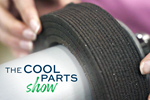3D Printing Rotors for Electric Motors (Video)
Oak Ridge National Laboratory describes research into applying additive manufacturing to replace windings in DC motors.
Can we 3D print an electric motor? Maybe yes for one vital component of it: the rotor — and that possibility holds important promise for better motor performance. Amiee Jackson is a researcher with Oak Ridge National Laboratory’s Manufacturing Demonstration Facility, and in this video, she discusses her work in producing rotors via laser powder bed fusion. Rotors are usually made by winding a conductive alloy. Changing the alloy composition to improve motor performance impedes manufacturing, because that change reduces the ductility that is important for winding. By offering a way to print the rotor with no winding involved, additive manufacturing potentially solves this problem.
Related resources:
- Oak Ridge National Laboratory’s Manufacturing Demonstration Facility
- AM technology from Renishaw
- More on laser powder bed fusion
- Additive manufacturing for another motor component: magnets
Related Content
-
Possibilities From Electroplating 3D Printed Plastic Parts
Adding layers of nickel or copper to 3D printed polymer can impart desired properties such as electrical conductivity, EMI shielding, abrasion resistance and improved strength — approaching and even exceeding 3D printed metal, according to RePliForm.
-
AM 101: NanoParticle Jetting (NPJ)
The proprietary process from XJet builds ceramic and metal parts using nanoparticle suspensions. Learn how NPJ works in this introductory article, part of our AM 101 series.
-
How to Build 10,000+ Shot Molds in Hours
Rapid tooling isn’t so rapid when it takes days to 3D print a metal mold, and then you still must machine it to reach the necessary tolerances. With Nexa3D’s polymer process you can print a mold in hours that is prototype or production ready and can last for more than 10,000 shots.





.png;maxWidth=300;quality=90)







